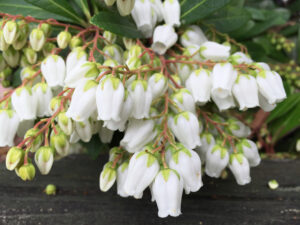
In the world of gardening, there are certain plants that quietly steal the show with their understated elegance and year-round charm. Among them, the Cavatine Pieris japonica stands out as a beloved favorite among gardeners for its compact habit and captivating blooms. Let’s take a closer look at what makes this shrub a delightful addition to any garden landscape.
Native to Japan, the Cavatine Pieris belongs to the Ericaceae family, sharing lineage with rhododendrons and azaleas. Its glossy, leathery leaves emerge in vibrant shades of red or bronze before maturing into a deep green, adding subtle color and texture to the garden year-round.
One of the highlights of the Cavatine Pieris is its delicate flowers, which bloom in early spring. Clusters of white, bell-shaped blossoms adorn the branches, creating a charming display. These blooms not only add visual appeal but also attract the early pollinators, making the shrub a welcome addition to any garden ecosystems.
Beyond its long-lasting springtime blooms, the Cavatine Pieris continues to impress with its evergreen foliage, providing interest and structure throughout the seasons. Its compact, mounded form makes it a versatile choice for various garden settings, from borders to foundation plantings to containers. Better yet, Pieris is fairly deer resistant.
Caring for the Cavatine Pieris is relatively simple, making it suitable for gardeners of all skill levels. This shrub thrives in partial shade and prefers moist, well-drained soil. Regular watering, especially during dry periods, will help keep the soil consistently moist and promote healthy growth. Pruning is generally not needed with this low-maintenance shrub, but if you’d like, do so after flowering.
Cavatine Pieris is a garden favorite for good reason. With its graceful foliage, charming blooms, and ease of care, it adds beauty and elegance to any landscape. Whether used as a focal point or planted en masse, this delightful shrub is sure to bring joy to any garden setting.
Learn more here.
